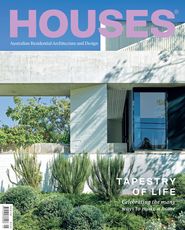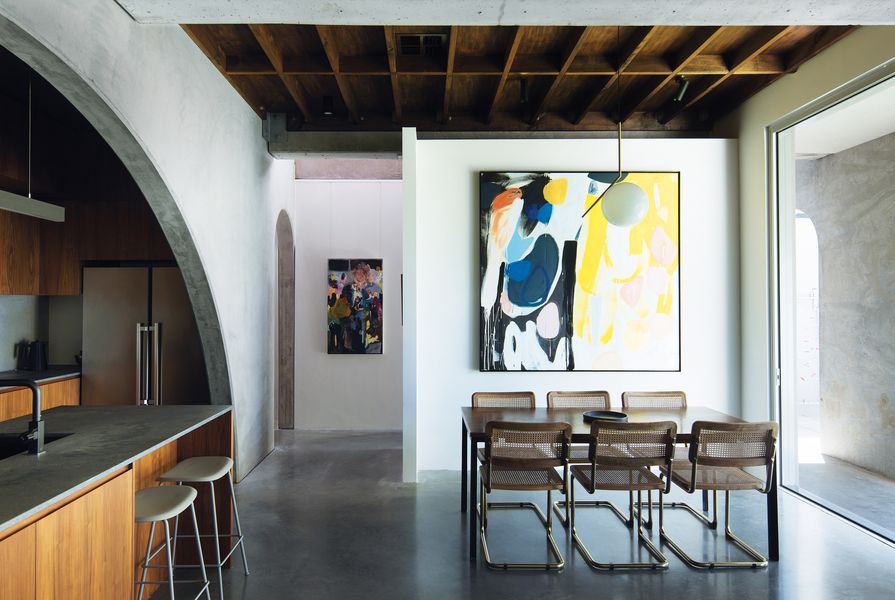Architecture can rarely be made without the conscious use of precedent: past works, preferably of enduring quality, being used by architects as a springboard for new work that responds to its own time. This is part of how architects learn. It is also how local traditions were once established in regionally discrete and often isolated places that achieved slow, incremental improvement. It is impor-tant, therefore, when reflecting on Nic Brunsdon’s North Perth House, that it is put into context with its obvious reference point, the Tama Art University Library in Tokyo by celebrated Japanese architect Toyo Ito.
Ito’s building is dominated by more than 160 arches. The arches meet at intersecting points to provide structural support so that the library floor can be free of walls. The effect is profound: the concrete building suddenly feels lightweight. Long, winding vistas are created through multiple sequences of archways and the “chambers” of space that they contain define loose rooms within a building that is otherwise fluid. It has the lofty sense of a Victorian-era railway station.
The heaviness of the concrete building is offset by the form of the arches and the timber joinery.
Image: Benjamin Hosking
I had many questions prior to visiting North Perth House. Was this reference point reasonable? After all, the scale of the house is entirely different from the Japanese library. Would there be enough walls and arches to achieve the desired effect? Where Ito’s arches are almost always “empty,” wouldn’t a house on a small lot require a fair number of its arches to be filled in order to create discrete rooms and privacy? Ito’s building was designed to be seen “in the round,” so what would be the consequence of making a small house on a small lot where it would be hemmed in? Where Ito’s walls intersect on a warped, radial grid, would it matter that North Perth House’s walls lie parallel to each other, running east–west at ground level only to be turned 90 degrees at the first-floor level? Would this strict arrangement – what architects call the diagram – compromise the house’s planning? Ultimately, what kind of a house would this make and how could it be achieved on an incredibly modest budget?
First, to the house’s planning. Rather than being compromised, it is incredibly efficient. Every room has good proportions. Where hallways and circulation are required, they serve dual functions – movement, gallery, laundry, display and storage – and the most delightful of these are the oversized first-floor landings, which double as a reading room and a study. These landings reward with internal vistas across the double-height hallway spine, experiences that are beyond uncommon nowadays in a house of such small proportions. This results in the house’s best views being completely internalized, and wonderfully unexpected and labyrinthine; fuel for the imagination. I’d like to be a child growing up here, reading Harry Potter.
The first-floor landings double as a reading room and study. Artwork: Elle Campbell.
Image: Benjamin Hosking
Why build a house of arches when such a high proportion of them will be infilled to make rooms? From a functional perspective, it isn’t immediately apparent; however, this approach has resulted in a compelling quality throughout. These moments of infill – translucent glazing at the house’s sides, tiled surfaces in the bathrooms and cabinets where storage is needed – become curiosities or material cues that signal your location in the house. They reinforce the house’s generating idea through inscription rather than through space or vista.
Externally, does it matter that the house is not seen “in the round,” as Tama is? In short, no. The ground floor’s side walls are obscured, pushed to the boundary line to maximize floor space. The upper floors are inset from these in order to address town planning setback regulations. And by pivoting away from Tama, something else has become possible: the house’s form could be repeated along the street as terraced houses are. From this, a new street pattern or context could emerge. The house’s design wouldn’t need to be altered to achieve this and its principal quality – its complex interiority – would be maintained. North Perth House shows how our expectation of external views from a house’s centre can be superseded by an intriguing interior. This quality is an impressive feat in itself but it would also, in a terraced model, ensure privacy between lots.
At some point in its design development, North Perth House ceased to be entangled with its Japanese starting point and became its own pursuit. Built for an almost impossible budget, North Perth House becomes a model for other architects and designers to explore further.
Products and materials
- Roofing
- Lysaght Trimdek roof cladding
- External walls
- XL Precast precast concrete; Danpalon multicell polycarbonate sheet in ‘Opal’
- Internal walls
- XL Precast precast concrete; American black walnut
- Windows
- CWD Glass and Aluminium windows; Viridian Comfortplus glass in ‘Grey’ and ‘Translucent’; Aneeta sashless windows; Architectural Window Systems framing
- Doors
- M and B solid core doors; custom American black walnut sliding door by Joondalup cabinets
- Flooring
- Virtscapes concrete floors; Woodpecker Flooring timber tongue and groove flooring in American black walnut
- Lighting
- Wall fittings from The Montauk Lighting Co.; additional fittings from Mobilia
- Kitchen
- Miele appliances
- Bathroom
- Nood Co. concrete basins in ‘Pastel Peach’ and ‘Mid Tone Grey’
- Other
- Balustrade by Decor Wrought Iron
Credits
- Project
- North Perth House by Nic Brunsdon
- Architect
- Nic Brunsdon
Perth, WA, Australia
- Project Team
- Nic Brunsdon, Michelle Kar, Craig Nener, Jaxon Webb, Adam Reynolds
- Consultants
-
Builder
Collier Homes
Engineer Talisman Consulting
Interior styling Kasiani Amara
Joiner Joondalup Cabinets
- Aboriginal Nation
- North Perth House is built on the land of the Whadjuk people of the Nyoongar Nation.
- Site Details
-
Location
Perth,
WA,
Australia
Site type Suburban
Site area 230 m2
Building area 190 m2
- Project Details
-
Status
Built
Completion date 2019
Design, documentation 16 months
Construction 12 months
Category Residential
Type New houses
Source

Project
Published online: 18 Jun 2021
Words:
Simon Pendal
Images:
Benjamin Hosking
Issue
Houses, October 2020

























